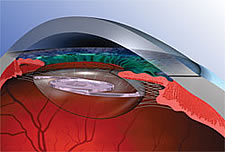Today, many people choose to correct their refractive errors with techniques other than wearing eyeglasses or contact lenses. Surgeries like laser-assisted in situ keratomileusis, or LASIK, improve vision by permanently changing the shape of the cornea to redirect how light is focused on the retina. However, in certain cases, LASIK or other refractive surgeries to reshape the cornea may not be a patient’s best option. In these cases, instead of reshaping the cornea, the eye’s natural lens can be removed and replaced with an intraocular lens (IOL) with a procedure called a refractive lensectomy.
 IOLs are artificial lenses surgically implanted in the eye. These lenses help your eye regain its focusing and refractive ability. Refractive lensectomy can be used to correct moderate to high degrees of myopia (nearsightedness) and hyperopia (farsightedness). In many cases, it is especially useful in treating presbyopia, the inability to focus at near distances with age.
IOLs are artificial lenses surgically implanted in the eye. These lenses help your eye regain its focusing and refractive ability. Refractive lensectomy can be used to correct moderate to high degrees of myopia (nearsightedness) and hyperopia (farsightedness). In many cases, it is especially useful in treating presbyopia, the inability to focus at near distances with age.
The most common type of implantable lens is the monofocal or fixed-focus lens. It helps you attain clearer vision at one distance. Note that eyeglasses or contact lenses are still required to see clearly at all ranges of distance.
Another type of IOL is the multifocal IOL. The multifocal IOL has several rings of different powers built into the lens. The part of the ring you look through will determine if you can see clearly at far, near, or intermediate distances.
A third type of IOL is the accommodative IOL. This IOL has a hinge designed to work with your eye muscles, allowing the lens to move forward as the eye focuses on near objects and backward as the eye focuses on distant objects. Other styles of accommodative IOLs are currently being developed.
 Implanting an IOL takes about 30 minutes in an outpatient procedure much like cataract surgery. In addition to a preoperative eye exam, your ophthalmologist takes certain measurements of the eye. Your eyes are then numbed with topical or local anesthesia. A few small incisions are made at the edge of the cornea. Then a small ultrasound instrument is inserted into the eye to break up the center of the eye’s natural lens. The lens is vacuumed out through one of the incisions. The IOL is usually folded and then inserted through the same incision. These incisions are usually self-sealing, requiring no stitches.
Implanting an IOL takes about 30 minutes in an outpatient procedure much like cataract surgery. In addition to a preoperative eye exam, your ophthalmologist takes certain measurements of the eye. Your eyes are then numbed with topical or local anesthesia. A few small incisions are made at the edge of the cornea. Then a small ultrasound instrument is inserted into the eye to break up the center of the eye’s natural lens. The lens is vacuumed out through one of the incisions. The IOL is usually folded and then inserted through the same incision. These incisions are usually self-sealing, requiring no stitches.
Once implanted, multifocal and accommodative IOLs allow you to focus on near or distant objects. You will probably have to take an antibiotic and steroid eyedrop for several days after the procedure, and you will need to wear an eye shield at night for one week to protect the eye.
Some advantages of refractive lensectomy are that unlike other forms of refractive surgery, refractive lensectomy can be used to treat people with dry eye, thin corneas, or high refractive error. In addition, if you have refractive lensectomy, you will never develop cataracts, as the natural lens is removed.
Risks associated with implanting IOLs include overcorrection or undercorrection, infection, increased “floaters” or retinal detachment, dislocation of the implant, halos and glare, dry eye, decreased contrast sensitivity, clouding of a membrane behind the IOL (this requires a quick laser procedure to remove it), and loss of vision.
You should consult with your ophthalmologist to determine if refractive lens exchange is the best treatment for your specific condition and vision needs. If you are considering refractive lensectomy, you should also discuss which IOL might be best suited for you.

